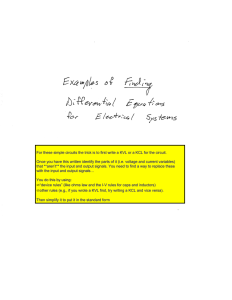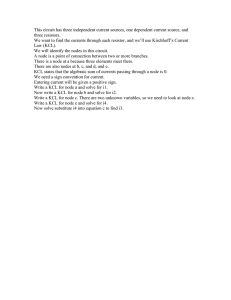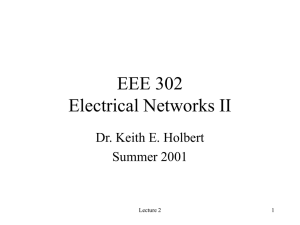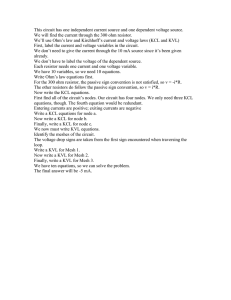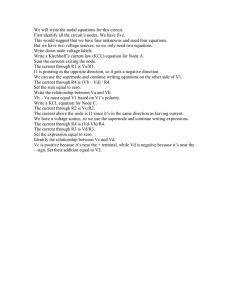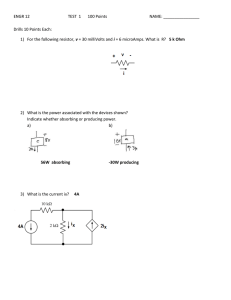Lecture 02
advertisement
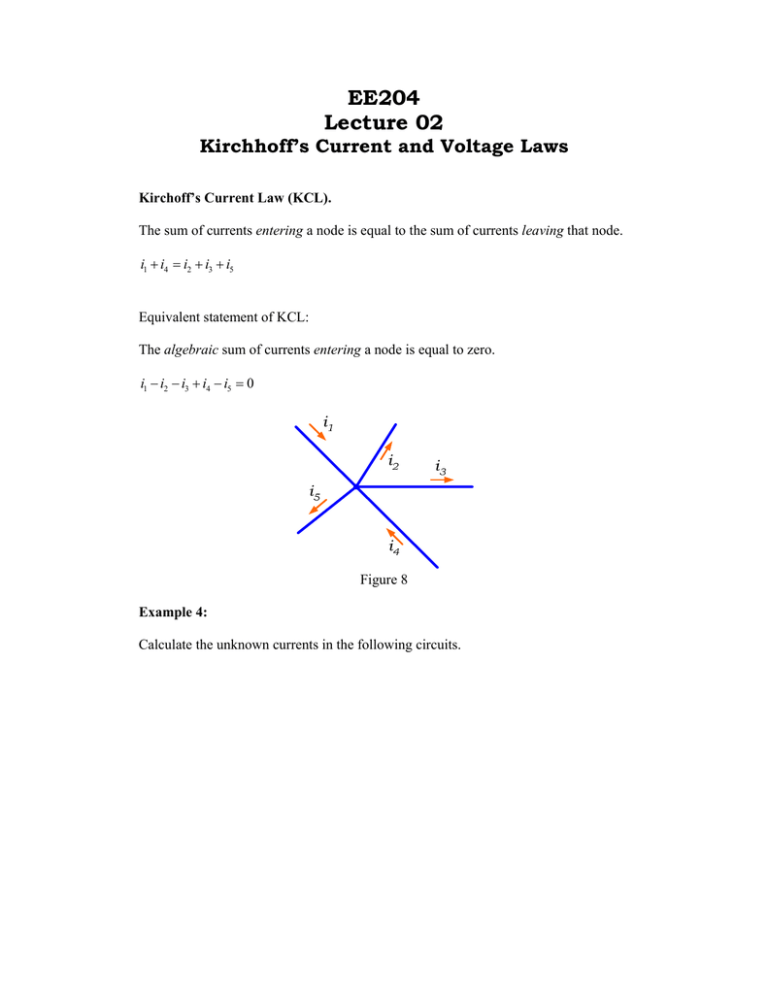
EE204 Lecture 02 Kirchhoff’s Current and Voltage Laws Kirchoff’s Current Law (KCL). The sum of currents entering a node is equal to the sum of currents leaving that node. i1 + i4 = i2 + i3 + i5 Equivalent statement of KCL: The algebraic sum of currents entering a node is equal to zero. i1 − i2 − i3 + i4 − i5 = 0 Figure 8 Example 4: Calculate the unknown currents in the following circuits. Ω Ω Ω Ω Ω Ω Ω Ω Ω Ω Figure 9 Solution: a) KCL at node (a) ⇒ i1 = 2 + 4 = 6 A b) KCL at node (a) ⇒ 3 + i1 = 1 ⇒ i1 = −2 A ⇒ 3 + i1 − 1 = 0 ⇒ i1 = −2 A ⇒ i1 − 4 + 2 = 0 ⇒ i1 = 2 A 0.5 − i2 − 2 = 0 ⇒ i2 = −1.5 A Alternatively KCL at node (a) c) KCL at node (b) KCL at node (c) ⇒ Check KCL at node (a) ⇒ −i1 + 4 + i2 − 0.5 = −(2) + 4 + (−1.5) − 0.5 = −4 + 4 = 0 KCL is also applicable to a closed area (super node). The algebraic sum of currents entering a super node is equal to zero. i1 + i2 − i3 + i4 − i5 = 0 Figure 10 Example: Calculate the currents i1 and i2 in the circuit shown below: Ω Ω Ω Ω Ω Ω Ω Ω Figure 11 Solution: KCL at super node 1 ⇒ 3 − i1 = 0 ⇒ i1 = 3 A KCL at super node 2 ⇒ i2 = 0 ⇒ i2 = 0 A Ω Ω Ω Ω Figure 12 Kirchoff’s Voltage Law (KVL): The algebraic sum of voltages around any closed circuit is equal to zero. CW = clockwise & −v1 − v2 + v3 − v4 + v5 = 0 (1) +v1 + v2 − v3 + v4 − v5 = 0 (2) [same as ⇒ ⇒ KVL around circuit 1 (CW) KVL around circuit 1 (CCW) (1)] CCW = counterclockwise ⇒ KVL around the outer circuit (CW) KVL around circuit 2 (CW) ⇒ −v6 + v8 + v3 − v4 + v5 = 0 −v6 + v7 = 0 ⇒ (3) v6 = v7 (parallel elements) Figure 1 Alternative KVL Statement: The algebraic sum of voltages between two nodes is independent of the path taken from the first node to the second node. path1&2 KVL Node a → Node b ⇒ Node b ⇒ +v2 + v1 = + v3 − v4 + v5 (4) [same as (5) [same as (1)] path 2&3 KVL (3)] Node a → +v3 − v4 + v5 = −v8 + v6 + V8 - Path 2 + V4 + - V5 Pa - - V2 V1 V7 - + V6 + V3 a Path 1 c th 3 b Figure 2 Example: Calculate the unknown voltages in the given circuit. Ω Ω Ω Figure 3 Solution: Applying KVL: Right-hand circuit (CW) ⇒ −(7) + v1 + (−1) + 10 = 0 ⇒ v1 = −2V Right-hand circuit (CCW) ⇒ +(7) − (10) − (−1) − v1 = 0 ⇒ v1 = −2V ⇒ +v1 = +(7) − (10) − (−1) ⇒ v1 = −2V path1&2 Node a → Node b Same answer in all cases. Left-hand circuit (CW) path 3&4 Node a → Node c ⇒ +(7) − (v2 ) = 0 ⇒ ⇒ +v2 = +7 ⇒ v2 = 7V v2 = 7V Same answer in both cases. Ω Ω Ω Ω Ω Ω Figure 4 Example: (KVL) Determine voltages vx, vy, vz in the circuit of fig….by applying KVL. Solution: KVL around the loop abcfa −vz + (−6) + 3 − 2 = 0 ⇒ vz = −6 − 2 + 3 = −5V (1) KVL around the loop fedef 2 + v y + (−1) = 0 ⇒ v y = −2 + 1 = −1V (2) KVL around the loop bcdeb −3 + 2 + vx − v y = 0 (3) To get vx we can substitute vy from (2) into (3) to get: vx = +3 − 2 + v y = 1 + (−1) = 0 ⇒ vx = 0V Note: We can also apply KVL around the loop febcdf to get vx directly: 2 − 3 + 2 + vx + (−1) = 0 ⇒ vx = −2 + 3 − 2 + 1 = 0V
